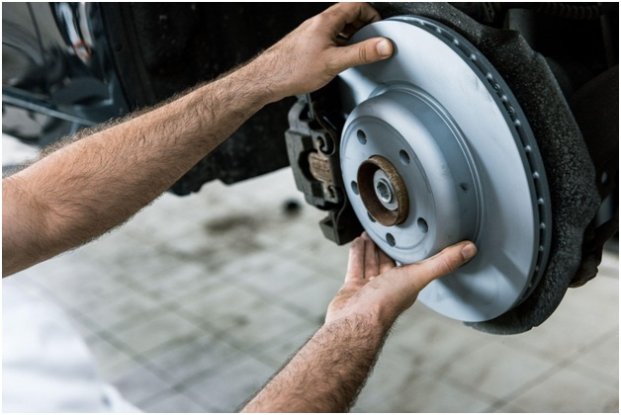Your braking system is one of your vehicle’s essential safety components. Without it functioning correctly, you can expose yourself to risky situations and put yourself and others on the road in jeopardy.
Whether you’re a novice car owner looking to replace your brake pads and rotors, or a seasoned enthusiast who wants to know more about how the braking system works, we’ve got you covered.
This article will help you better understand your braking system and discuss the importance of your brake pads and brake rotors. Let’s dive in!

Table of Contents
How to Pick the Best Brake Pads and Rotors?
First, let’s save you some trouble if you’re looking to replace your brake pads and rotors. These are some key factors you should consider before picking out the new gear:
Compatibility: Make sure that the design of pads and rotors is suitable for your car model. Using the wrong size or type can cause safety problems with the braking system.
Material: Brake pads and rotors are made from various materials, each with unique characteristics and benefits. For example, metallic brake pads are known for their durability and strong braking force, while ceramic brake pads are known for their low noise and dust levels.
Similarly, cast iron and steel brake rotors are suitable for general driving conditions and are a good choice for most vehicles. Aluminum and ceramic rotors may be better for high-performance or racing vehicles or for drivers who prioritize weight reduction and improved braking performance.
Brand reputation: Look for brake pads and rotors from reputable brands to ensure that you get reliable components that perform well.
Price: Consider the cost of the brake pads and rotors, but also keep in mind that you often get what you pay for. While it may be tempting to opt for the cheapest option, in the long run, it may be better to go for high-end options and ensure the quality is up to par.
Warranty: Look for brake pads and rotors that come with a guarantee to get protection in case some issues occur.
With many brands of brake pads and rotors available, it can be challenging to determine which ones are best for your needs. You should consider various factors, such as the type of vehicle, driving conditions, and personal preferences.
Bosch is probably the most recognizable brand that produces a wide range of automotive parts and accessories. If you’re looking for gear replacement, you can inform yourself and learn more about Bosch QuietCast pads and rotors.

The Basics of Brake Pads and Rotors
Understanding car components can be challenging for novice drivers. Let’s go over some basics to help you understand what brake pads and rotors are.
Brake Pads
Brake pads are an element in a vehicle’s braking system that applies pressure on braking rotors when you push the brake pedal. After the force is applied, the brake pads clench on the rotor and create friction that reduces the speed of your vehicle.
Applying light pressure and coming to a gradual stop is the ideal way to ensure your brake pads last for a long time. Hard and late braking causes them to wear out quickly.
Brake pads are typically made of metallic and ceramic materials. The friction from constant stopping wears them down, so they need to be changed when they become less effective. Make sure to keep an eye on the thickness of your pads to help determine if you should replace them.
Brake Rotors
Brake rotors, also known as brake discs, are circular plates inside car wheels. The brake rotors rotate with the wheel hub, connected to your wheels and tires via the lug nuts. These rotors turn with the wheel, and the pads make contact with them to create friction that slows your vehicle under braking pressure.
Brake rotors are usually made from steel, iron, ceramics, or aluminum. Generally, they last longer before needing replacement. You can typically ride on the same brake rotors for up to 70000 miles under normal braking conditions. But, if you wait until the last minute and brake hard or spend a lot of time in traffic, the life span of your rotors can decrease drastically.

How do Brake Pads and Rotors Work?
The brake system provides a smooth, controlled, and safe driving experience. But how exactly does it work?
Let’s look at all the braking elements, see how they function together and how brake pads and rotors work within the system. A braking system consists of the following:
- A brake pedal: When the driver pushes on the brake pedal, it activates the master cylinder. This hydraulic pump converts the mechanical force of the pedal into hydraulic pressure.
- Brake lines: The brake lines are tubes that carry the hydraulic fluid from the brake master cylinder to the brake calipers.
- Brake calipers: These components apply pressure to the brake pads to create friction and slow the vehicle down. They are located near the wheels and are usually mounted on the suspension.
- Brake pads: These flat, rectangular pieces are mounted on the brake caliper. When the caliper applies pressure to the pads, they apply force against the brake rotors.
- Brake rotors: When the brake pads press against the rotors, the friction between them slows the wheels and the vehicle down.
When Should You Change Brake Pads and Rotors?
A general consensus is that brake pads should be replaced every 10,000 to 20,000 miles to reduce wear. Rotors are more durable than pads and should be replaced between 50,000 and 70,000 miles to keep your brakes healthy and safe.
If you don’t know your car’s exact mileage, look for signs that it needs a brake pad or rotor replacement. Common warning signs include:
- Loud Screeching: If you hear high-pitched screeching when you slow down, it could be a sight that you need to replace your brake pads or rotors.
- Vibrations in your Steering Wheel: Rumbling in your steering wheel when slowing down signals the wear and exposure to excessive heat on your brake pads.
- Grinding Noises: If your vehicle no longer screeches and instead makes a grumpy gurgling sound when you brake, it could mean that your brake pads have worn through completely.
Should you Replace Brake Pads and Rotors on Your Own?
If you’ve decided to replace your brake pads and rotors, there are some basic rules you need to follow to ensure safety. Numerous tutorials online from experienced mechanics help with brake pads and rotor replacements. You could do it yourself and save money by skipping a visit to the mechanic shop.
However, if you aren’t very handy, it’s best to get help from a qualified car mechanic. If you make a mistake while replacing gear, you could cause more damage and need even more professional interventions, so proceed cautiously.
Make Your Engine’s Health a Top Priority
Without functional brake pads and rotors, the brakes would not function properly, putting you in danger on the road. But now that you know more about your car’s braking system, you can take good care of it and confidently embark on driving adventures.
Never overlook the quality of your brake pads and rotors, and regularly check if they’re in good condition. Have fun, and drive safely!




